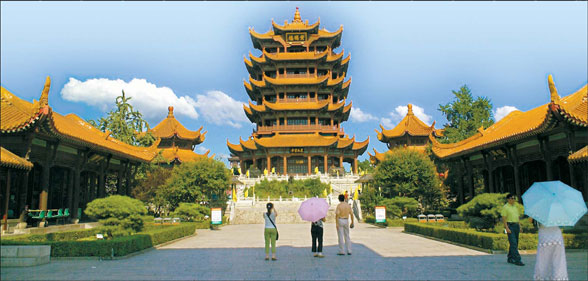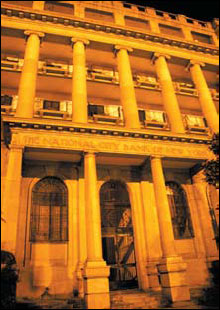|
 |
| The Yellow Crane Tower, built in AD 223, bears witness to the ups and downs of Wuhan. Song Jianchun |
An old man sits on a small stool, with pencil in hand, quietly sketching his local surroundings. He isn't drawing the famous Yangtze River, which seems to attract other Wuhan artists. The local's focus is on one of his city's old foreign buildings, which add so much charm and character to Central China's most populous metropolis.
Wuhan, capital of Hubei province, has a wide, 4-km-long boulevard, which runs along the Yangtze, and just like Shanghai, has many grand-style colonial buildings lining its riverside. The old National City Bank of New York building stands tall and proud, with its classical columns rising high, reflecting America's booming prosperity at the turn of the 20th century. Today this bank is called Citibank, America's largest bank. Opposite, renovated parklands run along the river banks, reflecting China's new prosperity. But in the backstreets, hundreds of smaller buildings echo China's colonial past.
More than 100 years ago, when the Qing Government was sinking into bankruptcy, foreign nations bailed out the declining dynasty with big loans. In return, foreigners were given trading concessions and Wuhan was one of the concession areas. Americans, Germans, Russians, Japanese, French, English and even the Polish, erected big offices and homes trimmed with charming articulation on their facades.
They are scattered everywhere, making Wuhan's downtown roads look a little like Hanoi's bustling backstreets. The Vietnamese capital's French architecture blends exotically with the busy local street life and Wuhan's similar setting paints a unique China picture.
The local government has wisely preserved the architecture and it's only a matter of time before the city's successful urban professionals move into this relatively undeveloped area, bringing with them modern restaurants, shops, bars, coffee shops and their urban cool lifestyles.
Of course, there is much more to this city of 9 million than old foreign buildings. Up to the mid-20th century, Wuhan was comparable to Shanghai and Beijing in manufacturing and educational development. The coastal-oriented reform and opening up policies changed this balance but now Wuhan is catching up and undergoing revitalization.
Wuhan's strategic position in Central China has always made it a major transportation hub, with dozens of railways and roads passing through. It has become the Detroit of China with Citroen, Honda and Nissan cars rolling off production lines at breakneck speed.
The city links nine provinces and it was no wonder foreigners wanted to set up shop here, in the same way the Chu people did about 3,000 years before. The city name, Wuhan, is relatively new and was only formed in 1927 after the merging of three different cities - Wuchang on the east bank of the river, and Hankou and Hanyang on the western side.
Wuhan is surrounded by busy waterways, mainly the Yangtze and Han rivers, and the famous East Lake. The Wuhan wharves on the Yangtze River are launch pads for many cruises up the river.
The lake is huge and has sandy beach areas, which are packed during the long hot summers. Wuhan temperatures are famous for soaring past 40 C in summer. Narrow roads snake around the mass of water and are lined with drooping trees.
On the lake's southeast side is Moshan Hill, which features the imposing Chutian Tower symbolizing the power of the ancient State of Chu. The Moshan Hill parklands offer a pleasant walk.
 |
| The National City Bank of New York is one of the old colonial buildings in Wuhan. Patrick Whiteley |
|